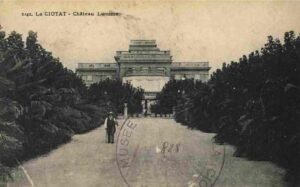When Louis de Freycinet was looking for a suitable vessel for his round-the-world expedition, he rejected the first one that he was offered, but eventually found just what he was looking for in the French port of La Ciotat, near Toulon. A port that only last week was the subject of an article in the Guardian newspaper, lauding its ice-cream parlours, art deco café and sunshine. And its history.
La Ciotat, as I didn’t know, simply means ‘The City’, in Occitan or Provencal or even Catalan. Which seems an odd name for a smallish port (population about 40,000) halfway between the major harbours of Marseille and Toulon and now specialising in fitting-out superyachts.
Back in the 15th Century, however, things were very different. In 1429 La Ciotat was granted its charter as an independent commune, and for the next a hundred years it became a place of refuge for Genoese aristocrats fleeing a home city that had become a battleground between France and Spain. It was probably these immigrants that established a shipyard specialising in building vessels to carry away the local olive oil, wine, wheat and soap, and tp bring back the spices, silks, carpets, perfumes and porcelain desired by the increasingly prosperous inhabitants. In 1816 that same shipyard, recovering from a long period of decline, was putting the finishing touches to a three-masted trading vessel or gabare named, rather unimaginatively, after the town itself when it was visited by Louis de Freycinet. Perhaps the name was just a working title, and every such ship built there was first named La Ciotat, but whether or not that was the case, after Louis had seen her and had her transferred to the naval dockyards at Toulon for conversion to a warship, he also re-named her. She became the corvette Uranie.
If La Ciotat had been forced to rely only on the nearly forgotten (in its own country at least) voyage of the Uranie for its place in history, it would be little known indeed, but the city has two other, more recent, claims to fame. Two, in fact. It was in La Ciotate that, on September 21st, 1895, the cinematograph was first demonstrated to the public by the aptly named Louis Lumière at his family home, the imposing Chateau Lumière. It was not until three months later that there was a showing in Paris, and before that there was a second showing at the still-existing Eden Cinema in La Ciotat itself.

Figure 1: Chateau Lumières, near La Ciotat. Picture : Booking.com
For many of the inhabitants of La Ciotat, however, the cinematograph would have been a mere distraction from their main preoccupation, the sport of boules, played at that time as La Longue. At the end of the Nineteenth century, the person despatching the boule would do it on the move, in a variant that required considerable athleticism, and in the years leading up to 1907 one of its leading exponents had been a man called Jules Lenoir. By 1907, however, his arthritis had got the better of him. The smooth run up to the release of the heavy metal ball was beyond him, and he was reduced to the role of spectator.
There was another man who shared his frustration, the one-legged the café owner Ernest Pitiot. Between them they devised a new variant, in which the player releasing the ball was required to remain within a small circle with both feet firmly planted on the ground (pieds tanqués), with, of course, an allowance made for those like Pitiot, lacking one or both feet. Pétanque was born, and in our sedentary times, has just about replaced La Longue.
